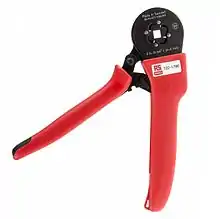
Crimping is a method of joining two or more pieces of metal or other ductile material by deforming one or both of them to hold the other. The bend or deformity is called the crimp.[1][2] Crimping tools are used to create crimps.
Crimping is used extensively in metalworking, including to contain bullets in cartridge cases, for electrical connections, and for securing lids on metal food cans. Because it can be a cold-working technique, crimping can also be used to form a strong bond between the workpiece and a non-metallic component.
Description
In metalworking, crimping is a method of joining two or more pieces of metal or other ductile material by deforming one or both of them to hold the other. The bend or deformity is called the crimp.[1][2] Because it can be a cold-working technique, crimping can also be used to form a strong bond between the workpiece and a non-metallic component.
Tools
A crimping tool or crimp tool is used to created crimps.[1][2] Crimping tools range in size from small handheld devices to benchtop machines used for industrial purposes.[3][2]
Uses

Crimping is most extensively used in metalworking. Crimping is commonly used to fix bullets in their cartridge cases, for rapid but lasting electrical connections, for securing lids on metal food cans, and for many other applications.
Bullets
Canning
Connectors

Metals are joined via a special connector. Stripped wire (often stranded) is inserted through the correctly sized opening of the connector, and a crimper is used to tightly squeeze the opening against the wire. Depending on the type of connector used, it may be attached to a metal plate by a separate screw or bolt or it could be simply screwed on using the connector itself to make the attachment like an F connector.
Jewelry
In jewelry manufacture, crimp beads, or crimp tubes, are used to make secure joints in fine wire, such as used in clasps or tie loops. A crimped lead (or other soft metal) seal is attached to secure wires used to secure fasteners in aircraft, or to provide visual evidence of tampering when securing a utility meter or as a seal on cargo containers.
Plumbing
In plumbing, there is a trend in some jurisdictions towards the use of crimped fittings to join metallic pipes, replacing the traditional soldering or "sweating" of joints. This trend is driven in part by increased restrictions or bans of processes involving open flames, which may now require costly special permits.
Sheet metal
When joining segments of tubular sheet metal pipe, such as for smoke pipes for wood stoves, downspouts for rain gutters, or for installation of ventilation ducting, one end of a tube is treated with a crimping tool to make a slip joint into the next section of duct. The joint will not be liquid-tight but will be adequate for conveying low pressure fluids. Crimp joints may be arranged to prevent accumulation of dirt.
See also
References
- 1 2 3 "What is a Crimping Tool?". www.computerhope.com. Retrieved 2023-11-15.
- 1 2 3 4 "What Is a Crimping Tool Used For? - Woodsmith Guides". Woodsmith. 2022-08-14. Retrieved 2023-11-15.
- ↑ "5 Types Of Crimping Tools Explained". www.heamar.co.uk. Retrieved 2023-11-15.